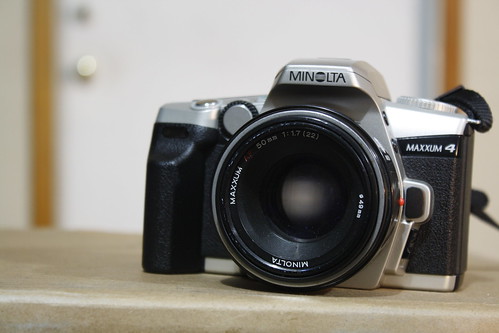Difference between revisions of "Minolta Maxxum 4"
(added dynax4 photo) |
Hanskerensky (talk | contribs) (Added link to user manual page) |
||
| (9 intermediate revisions by 3 users not shown) | |||
| Line 1: | Line 1: | ||
| − | + | ''This is not to be confused with the [[Minolta Dynax 3L|Minolta Maxxum 3, GT, Dynax 3L]], or the [[Minolta Dynax 3xi|Alpha 3xi]]'' | |
{{Flickr_image | {{Flickr_image | ||
|image_source= http://www.flickr.com/photos/god-son/4087749289/in/pool-camerawiki/ | |image_source= http://www.flickr.com/photos/god-son/4087749289/in/pool-camerawiki/ | ||
| Line 11: | Line 11: | ||
The '''Maxxum 4''' is an autofocus 35mm SLR camera manufactured by [[Minolta]] in 2002. It is also known as the '''Dynax 4''' or in tetraphobia countries as the '''Dynax 3'''. In Japan it is known as the '''α-Sweet II L''' (Alpha Sweet II L) and in China as the '''α-3''' (Alpha 3). | The '''Maxxum 4''' is an autofocus 35mm SLR camera manufactured by [[Minolta]] in 2002. It is also known as the '''Dynax 4''' or in tetraphobia countries as the '''Dynax 3'''. In Japan it is known as the '''α-Sweet II L''' (Alpha Sweet II L) and in China as the '''α-3''' (Alpha 3). | ||
| − | + | The electronically controlled vertical travelling [[focal-plane shutter]] has speeds of 30s to 1/2000 of a sec. with a [[flash sync]] of 1/90. Exposure modes have PASM. The program exposure mode contains 5 separate modes including portrait, landscape, close-up, sport and night portrait. The metering is [[TTL]] based on a 14 segment honeycomb silicon photo cell with a range of 1 to 20 [[EV]] (ISO 100, f/1.4) and a spot metering range of 4 to 20 EV. It can use [[DX encoded]] films with speeds of 25 to 5000 ISO. Non-DX films can be set from 6 to 6400 ISO in 1/3 stops. | |
| − | + | The film transport is motorized with film advance settings of single or a continuous drive speed of up to 1.7fps. Rewinding the film is automatic at the end of the roll, but a manual rewind is also possible before the end of the roll. The built-in flash has a GN of 12. An AF illuminator is also on the flash, that enables more precise focusing in darker conditions. [[Self-timer]], exposure bracketing and [[multiple exposure]] is possible. The camera is powered by two [[CR2 battery|CR2 batteries]]. | |
| − | + | ||
| − | + | ==Links== | |
| − | + | *[https://www.butkus.org/chinon/minolta/minolta_maxxum_4/minolta_maxxum_4.htm Minolta Maxxum 4 user manual] at [https://www.butkus.org/chinon/ Butkus.org] | |
| − | |||
| − | |||
| − | |||
| − | |||
[[Category:Minolta AF mount|4 Dynax]] | [[Category:Minolta AF mount|4 Dynax]] | ||
| + | [[Category:Minolta|Maxxum 4]] | ||
| + | [[Category:M|Maxxum 4 Minolta]] | ||
[[Category:Japanese 35mm autofocus SLR]] | [[Category:Japanese 35mm autofocus SLR]] | ||
| + | [[Category:Infrared counter]] | ||
Latest revision as of 07:05, 23 January 2022
This is not to be confused with the Minolta Maxxum 3, GT, Dynax 3L, or the Alpha 3xi

|
| Maxxum 4 image by Joshua Itiola (Image rights) |
The Maxxum 4 is an autofocus 35mm SLR camera manufactured by Minolta in 2002. It is also known as the Dynax 4 or in tetraphobia countries as the Dynax 3. In Japan it is known as the α-Sweet II L (Alpha Sweet II L) and in China as the α-3 (Alpha 3).
The electronically controlled vertical travelling focal-plane shutter has speeds of 30s to 1/2000 of a sec. with a flash sync of 1/90. Exposure modes have PASM. The program exposure mode contains 5 separate modes including portrait, landscape, close-up, sport and night portrait. The metering is TTL based on a 14 segment honeycomb silicon photo cell with a range of 1 to 20 EV (ISO 100, f/1.4) and a spot metering range of 4 to 20 EV. It can use DX encoded films with speeds of 25 to 5000 ISO. Non-DX films can be set from 6 to 6400 ISO in 1/3 stops.
The film transport is motorized with film advance settings of single or a continuous drive speed of up to 1.7fps. Rewinding the film is automatic at the end of the roll, but a manual rewind is also possible before the end of the roll. The built-in flash has a GN of 12. An AF illuminator is also on the flash, that enables more precise focusing in darker conditions. Self-timer, exposure bracketing and multiple exposure is possible. The camera is powered by two CR2 batteries.